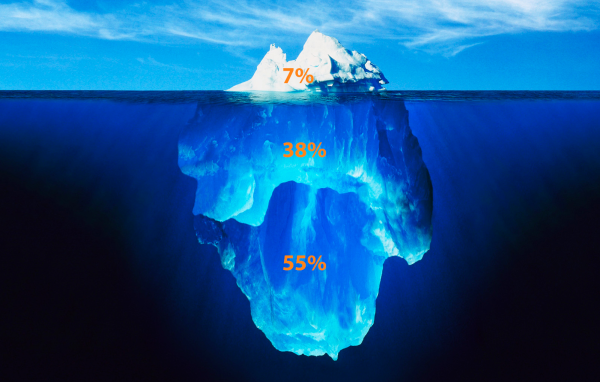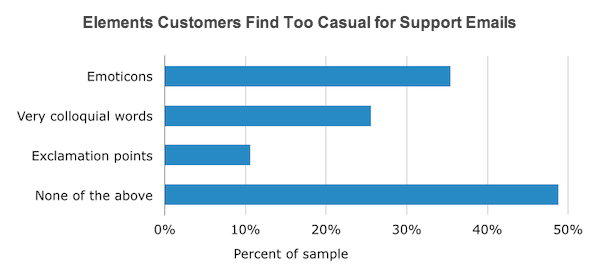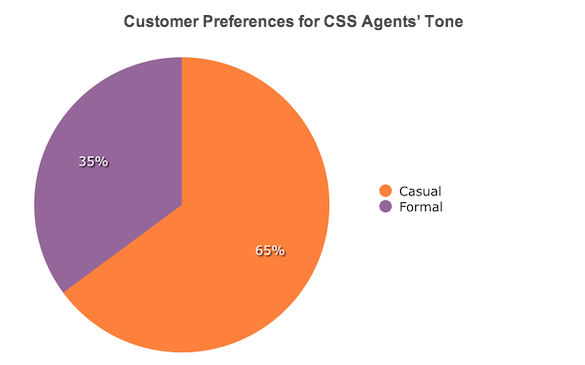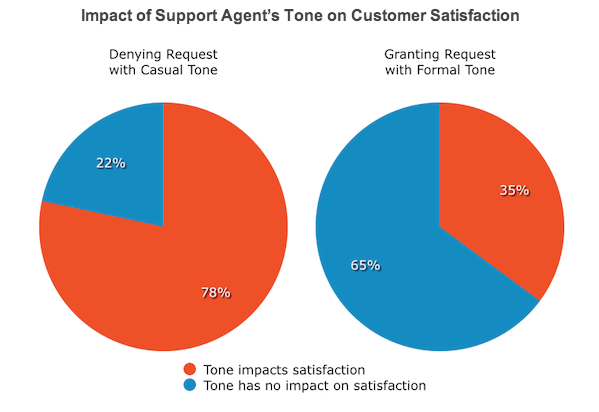In 1967, Albert Mehrabian came up with the “7%-38%-55%” rule determining that communication is made up of 3 parts:
- The actual words you use (7%),
- The tone of delivery (38%), and
- The body language accompanying your words (55%).
Hence, merely using positive language in conversations (e.g. “thank you”) only has a 7% impact on a customers. To truly connect with your customers you need to also incorporate a positive tone and body language.

What is this “Tone”?
Tone can mean a few different things, but it usually comes down to attitude – i.e. the quality or feeling expressed by the words you are using.
For example, MailChimp identifies its tone as distinctly different from its voice:
“There’s a difference between voice and tone. Look at it this way: You have the same voice all the time, but your tone changes. You might speak in one tone to your closest friends and family, and a different tone with your boss.”
Jay Ivey, an analyst at Software Advice, a company that evaluates customer service systems, says that a speaker’s “tone” over email, chat or any other textual medium is conveyed solely through language – i.e. diction, syntax, punctuation – not through the speaker’s tone-of-voice or body language.
However, customers remain quite sensitive to the attitudes expressed through these text communication channels. Therefore, it’s just as crucial for customer support staff to recognize how small changes in word choice or punctuation can alter their tone, and how to choose the right tone based on the listener’s feelings and expectations.
What “Tone” Should Customer Support Use?
Choosing the right tone for your customer support staff is not a one-off task. It needs to constantly evolve to meet the needs of your varying customer base.
Most marketers already understand the importance of building buyer personas, to help target different customers. Of equal importance is considering the type of tone to use in each support scenario.
You need to train your customer service staff to be empathetic to the needs of the customer. If the customer is particularly annoyed about something and just wants their problem solved, it’s not a good idea to joke about how “annoying it must be“.
On the other hand, if the customer is willing to play along, there’s nothing wrong with a bit of humour. It might just go viral.
Unfortunately, it’s not always possible to tell what kind of tone your customer will prefer and so Software Advice went ahead and researched what kind of tone people prefer in various support situations.
Note: Software Advice’s research focussed on email support, but I think it could apply just as easily to other channels.
Customers Prefer Informal Banter
Adopting a neutral tone is perhaps the safest method for support staff to engage customers, but sometimes that’s not what the doctor ordered.
In the first survey conducted by Software Advice, 65% of customers preferred their support staff to have a “casual” tone.
What was particularly interesting about this part of the survey was that the distribution was consistent across all age and gender demographics. Hence, no matter how young or old the customer was they usually preferred a casual tone.
Pro Tip: Be a human, not a robot. Whenever communicating with a customer, loosen up a bit and speak using natural language (e.g. use contractions, exclamation points, and informal words).
Context Matters: Customer Support must Tailor their Tone to Suit the Situation
Although, generally speaking, customers prefer a human, friendly tone, each support interaction is different and customer service staff must be able to react appropriately to the situation.
For example, according to Jay Ivey, customers are likely to interpret a casual attitude in a delicate situation as being insensitive, condescending or otherwise inappropriate.
The first graph above demonstrates that an overwhelming majority of customers would be dissatisfied if their request was denied using a casual tone (78%). In contrast is a request was granted in a formal tone, customers don’t tend to care as much (only 35% said it affected their satisfaction).
Pro Tip: Customer support teams should be cautious when interacting with upset or angry customers. These customers can be more sensitive to the tone used. It’s best to maintain a neutral tone and use other strategies to help calm things down.
Emojis and Colloquialisms are Sometimes Inappropriate
Casual banter can sometimes go too far.
In the last decade emoticons [ ;P ], emoji, and colloquialisms [“lol”] have become commonplace in digital communication. However, is this something that customers appreciate?

Jay Ivey does offer a caveat here. Unlike customer support email, live chat is inherently more casual. The back-and-forth nature of chat makes it easier to remember there’s a real human being on the other end. Hence, liberally using emoticons or colloquialisms might actually be appropriate.
Pro tip: Again read the situation. If the customer is using emoticons or colloquial language feel free to respond in kind.

